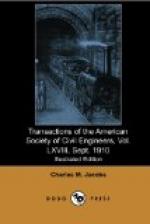The profile was adopted to give 18 ft. of clearance from the under side of the bridges to the top of the rail of the Erie Railroad branches, 21 ft. to the top of the rail of its main line, 19 ft. to the top of the rail of the Delaware, Lackawanna and Western Railroad, and a clearance of 24 ft. above high water in the Hackensack River. With the exception of that portion of the line adjoining the Bergen Hill Tunnels, where it was necessary to continue the 1.3% grade up to the bridge over the Northern Railroad of New Jersey, and the east-bound ascending grade of 0.5% from the Harrison platforms to the bridge over the New York Division tracks, the grades do not exceed 0.3 per cent.
When the construction of the embankment was commenced, it was expected that there would be considerable trouble by settlement due to the displacement of the soft material underlying the surface of the meadows to a depth of from 10 to 15 ft.; but, with the exception of the trouble the contractors had in maintaining their temporary trestles, the embankment as completed has settled very little. The section east of the Hackensack River was made, in great part, of rock excavated from a borrow-pit in the Town of Secaucus, north of the eastern end of the Division. The embankment was built under two contracts, one for the work east of the crossing of the Boonton Branch of the Delaware, Lackawanna and Western Railroad, under contract dated January 15th, 1907, with H. S. Kerbaugh, Incorporated, the material being taken from the borrow-pit in narrow-gauge cars and dumped from a strong pile trestle along the total length of the section, the same being completed in 19 months; the other for the embankment west of the Boonton Branch, Delaware, Lackawanna and Western Railroad, under contract dated April 10th, 1906, with Henry Steers, Incorporated, of New York City, the material, consisting partly of cellar earth, and partly of rock and earth excavated from other sections of the Pennsylvania Tunnel and Terminal Railroad, being brought on scows up the Hackensack and Passaic Rivers from New York City. The material was handled expeditiously from the scows by orange-peel buckets operated from the shore, deposited in standard-gauge dump-cars, and transported by locomotives at one time used on the elevated railroads in New York City. No excavation whatever was required on the Meadows Division or in the Harrison Yard.
[Illustration: Plate XVIII.—Details of Shelters and Platforms, Harrison Transfer Station.]
[Illustration: Plate XIX.—Details of Shelters and Platforms, Harrison Transfer Station.]




